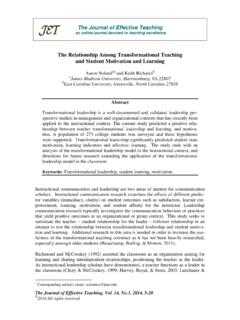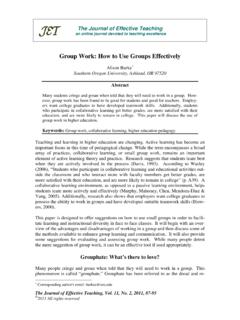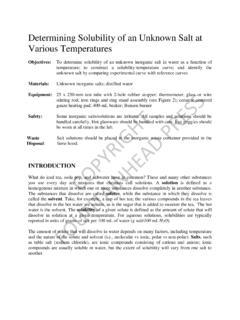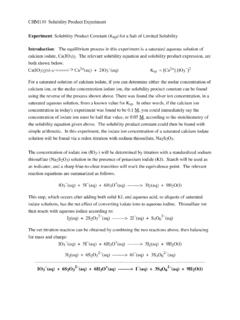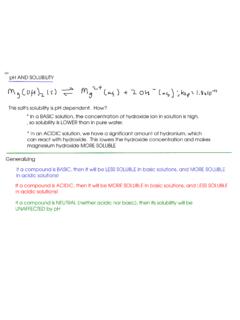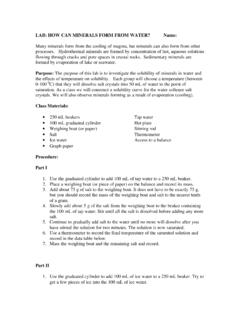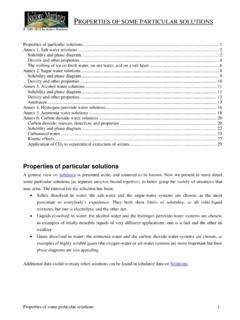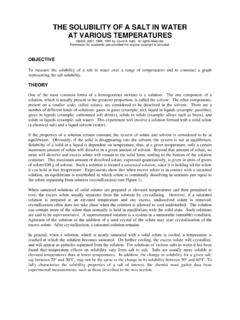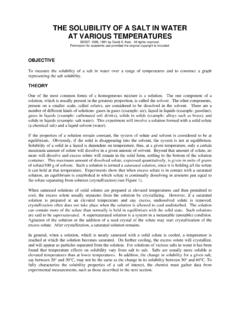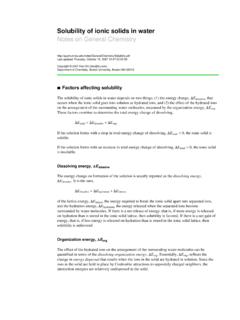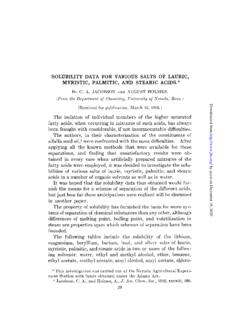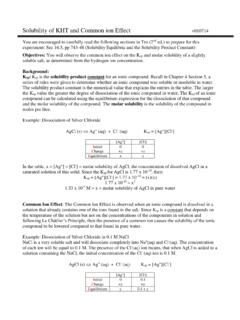Transcription of Solubility & Conductivity - uncw.edu
1 5s Solubility & Conductivity OBJECTIVES To explore the relationship between the structures of common household substances and the kinds of solvents in which they dissolve. To demonstrate the ionic nature of aqueous solutions of strong and weak electrolytes. To use symbolic expressions (chemical equations) to represent dissolution processes. INTRODUCTION The vast majority of the substances we encounter in our daily lives are mixtures, and many are solutions. A solution is a homogeneous mixture of two or more elements or compounds present in a single phase.
2 It is usual to think of the component present in the largest amount as the solvent and the other component(s) as the solute(s). Solutions such as coffee, soda, and household cleaners usually involve water as the solvent and are called aqueous solutions. Consumer products such as gasoline, paint thinner, and butter are solutions in which the solvent is a liquid other than water. Common household aqueous solutions Common household nonaqueous solutions Figure Intermolecular Forces and Solubility What makes one substance dissolve in another? Why is it that oil and water don't mix?
3 To answer these questions, we need to examine the concept of a solution on the atomic (sub-microscopic) scale. Molecules and ions exert forces (called intermolecular forces) on their neighbors. For the most part, these forces are attractive in nature, and they always become weaker as the distance between the interacting pairs increases. Because gas molecules are far apart (on average), intermolecular forces have little effect on their behavior, and solutions form rapidly when gases are mixed. The air we breather is a gaseous solution. Intermolecular forces play a significant role in the behavior of condensed phases (solids and liquids) since the molecules or ions are very close together in these phases.
4 If a solute is to dissolve in a solvent, the intermolecular attractive forces within the pure solute and within the pure solvent must be overcome. In other words, as depicted in Figure , solvent particles must be pulled away from one another (step 1) and solute molecules must also be pried apart (step 2) to allow the solute and solvent species to intermingle. Both of these processes require the input of energy. When separated solute and solvent particles are combined to form a solution, energy is released as these particles interact (step 3). Figure 1.
5 If, as in the case depicted above, the energy released by these intermolecular solute/solvent attractions (step 3) is less than the energy required to separate the pure solute and solvent molecules in the first place (steps 1 & 2), energy will be (supplied by or released to ) the surrounding solution, (raising or lowering) the solution's temperature. Mixing substances with weak intermolecular attractions for one another may result in the formation of two phases rather than a homogenous solution. Sub-microscopic Properties and Solubility When the electron density around a molecule is not distributed uniformly, the molecule is said to be polar.
6 The polarity of a molecule depends on the polarity of the bonds it contains as well as its overall geometry. Water is a polar molecule because the bonds between the oxygen and the two hydrogen atoms are polar (with higher electron density around the oxygen than the hydrogens) and the molecule itself is bent. solvent solute solution1 23E0 E1 E2 E3 1 2 3 Water Molecular Model Water Structural Formula/Dipole symbol Figure Gasoline, by contrast, consists mostly of hydrocarbons such as octane that contain only carbon and hydrogen, and because of their geometries and the fact that the bond between hydrogen and carbon is not (very) polar, these molecules are nonpolar.
7 Octane Molecular Model Octane Structural Formula Figure A polar substance will generally have strong intermolecular forces that involve the electrical attractions of the partially positive end of one molecule with the partially negative end of another. A polar solvent such as water can dissolve many polar or ionic solutes because its molecules have the same type of strong forces acting among them as do the potential solutes. Although inserting solute species between the water molecules requires that both the water molecules and solute particles separate from each other, the interactions between the solute and the water that occur when water molecules surround a polar substance can compensate for the loss of the intermolecular interactions between the now separated pure water and pure solute molecules.
8 On the other and, water will not dissolve a substance like gasoline that is not polar. The interaction between the inserted solute and solvent water molecules cannot replace the attractive interactions between water molecules and the materials don't mix. Non-polar solvents such as octane dissolve other non-polar substances because the molecules of both solute and solvent are held together by similar forces. These observations have been generalized in the rule of thumb like dissolves like. In the first part of this experiment, we will investigate the Solubility of different household chemicals in both polar and nonpolar solvents and speculate on the nature of the intermolecular forces.
9 Electrolytes When ionic compounds dissolve in water they separate (dissociate) into their free ions, each surrounded by water (hydrated). Consider the salt potassium chloride, composed of the alkali metal cation K+ and the halide anion Cl-. We would represent the dissolution process for this compound as Since ionic compounds are made up of ions, they interact well with polar solvents such as water, but show little affinity for nonpolar materials. Covalent compounds such as acetic acid (CH3CO2H) and hydrochloric acid (HCl) may also ionize, partially or extensively, upon dissolving.
10 Solutions that contain electrolytes conduct an electric current, indicating the presence of mobile ions. You are probably more familiar with electrolytes in the context of minerals in cells to maintain water balance, and indeed the aqueous environment of cells is an excellent example of an electrolyte solution. A substance that dissociates completely in water ( KCl or HCl) is said to be a strong electrolyte and will generally be a good electrical conductor whereas a substance that dissociates only to a small extent ( CH3CO2H, which is only 1% to 5% dissociated in water) is called a weak electrolyte, and conducts to a much more limited extent.


